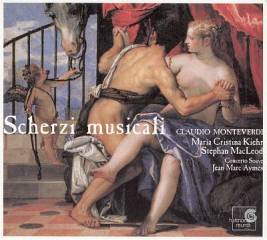Claudio Monteverdi – Scherzi Musicali (2005)
Claudio Monteverdi – Scherzi Musicali (2005)

1. Fugge 'L Verno De' Dolori 2. Come Faro Cuor Mio Quando Mi Parto 3. Lidia Spina Del Mio Core 4. Damigella Tutta Bella 5. Quel Sguardo Sdegnosetto 6. Piu Lieto Il Guardo 7. Et E Pur Dunque Vero 8. Si Dolce E 'L Tormento 9. Clori Amorosa 10. Ecco Di Dolci Raggi 11. Lo Che'Armato Sin Hor 12. Eri Gia Tutta Mia 13. Maledetto Sia L'Aspetto 14. Aria Detta Balletto (Frescobaldi) 15. Quando Sperai 16. Quando L'Alba In Oriente 17. Toccata Arpeggiata (Anonyme) 18. Se I Languidi Miei Sguardi 19. Ohime Ch'io Cado 20. De La Bellezza Le Dovute Lodi Maria Cristina Kiehr - Soprano Stephan MacLeod - Bass Baritone Concerto Soave Jean-Marc Aymes – conductor
Before turning to the performances on this splendid disc, it will be helpful to determine what it includes. The greater part of it is devoted to the two published sets of vocal chamber works entitled Scherzi musicali. The first, Scherzi musicali a tre voci , appeared in 1607 in Venice. The publication, which Monteverdi left his brother Giulio Cesare to oversee, includes 15 works for three voices, six of which are included on the present disc. In addition to its musical value, the 1607 Scherzi musicali is of great importance to historians for the preface, which includes further arguments advanced by Giulio Cesare in defense of the so-called seconda prattica (the term used here for the first time), or modern style, adopted and immeasurably advanced by Monteverdi.
The second set of Scherzi musicali appeared in Venice in 1632. Consisting mostly of solos in stil recititivo , it is here recorded complete with the exception of two pieces. In addition we are given two works from the 1584 Canzonette , examples of equal-voiced 3-part polyphony in the old prima prattica style, and Se i languidi , the famous “ lettera amoroso ” from the seventh madrigal book (1619). Although there is a Naxos recording of the complete 1607 publication ( Fanfare 22:3), recordings of the Scherzi are comparatively rare, being generally restricted to an odd number scattered about in more general collections.
Perceptive readers may by now have picked up on references in the above paragraphs to three-part compositions, but noted that only two singers are listed in the heading. The explanation is that in the works concerned, the canzonets and the 1607 Scherzi , one or more vocal part(s) are taken by instruments. In the case of the canzonets, there appears to be solid historical evidence for such practice, but I’m less convinced by the arguments advanced by Jean-Marc Aymes for performing the Scherzi in this way. They are scored for two sopranos and bass, and to my mind replacing the second soprano with a violin not only undermines the balance, the vocal lines being inevitably more prominent, but also the deliberately sensual effect Monteverdi so frequently sought in combining two equal high voices.
That said, the disc is a joy. As such rubrics as “canzonet” and “scherzo” readily suggest, this is for the most part Monteverdi in playful mode, particularly in the case of the 1607 Scherzi , which are dominated by infectious dance rhythms initially laid out by the introductory instrumental ritornellos with their two violins. The structure is strophic, the word-setting largely syllabic, although the composer is not averse to the odd touch of word painting on occasion. María Cristina Kiehr and the fine Swiss bass Stephan MacLeod bring to them a deliciously light touch, my sole reservation being that the tempo contrast in De la bellezza is surely too great, the verses being taken too slowly in comparison with the dance-like refrain.
The later Scherzi are more varied, ranging from short passages in recitative style ( Ecco di dolci raggi and Lo che’armato , both sung by MacLeod with a fine sense of dramatic structure) to more virtuosic pieces like Quel sguardo sdegnosetto , in which Monteverdi deploys the full armory of affetti over a quasi-ostinato bass. Both here and, indeed, throughout the disc Kiehr’s singing is superb, not only as to the golden, warm luster of her tone, but also the purity of its perfectly even production and intelligent control. One need only hear her total command of the expressive nuances in the long “ lettera amorosa ,” entirely composed in stile recitativo , to be conscious of being in the presence of a consummate artist. And how beautifully Kiehr catches the dreamlike languor of Si dolce è’l tormento (one of two pieces on the disc drawn from yet another publication, the Quarto Scherzo of 1624), the descending phrases almost lazily etching themselves on the memory. Kiehr’s long association with Concerto Soave ensures sympathetic support of the highest quality, with some fine playing from the violinists in the ritornellos of the 1607 Scherzi . Delightful music performed with supreme artistry. --- FANFARE: Brian Robins, arkivmusic.com
download: uploaded yandex 4shared mediafire solidfiles mega filecloudio nornar ziddu
Last Updated (Tuesday, 25 February 2014 14:36)








